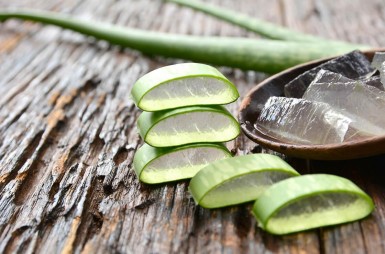Stretch marks:
small, unsightly scars that can have a negative impact on self image
Written by Marion, Aesthetician/Cosmetician | published on | updated on 16/06/2022

Fortunately, stretch marks are harmless and pose no threat to health. This does not stop them from being unsightly and difficult to deal with. Are they a simple fact of life? Not entirely. To tackle stretch marks effectively, let’s start by finding out more about them.
What are stretch marks?
Stretch marks are those ridges and vertical grooves that form on certain susceptible areas of the body, such as the stomach, hips, buttocks, breasts, thighs and arms and can cause us distress when it comes to wearing a swimming costume or a pair of shorts. Like a patch of earth that has suffered a drought and is cracked in places, stretch marks are the visible manifestation of irreversible tearing in the deep fibres of the skin.
Stretch marks develop in two stages:
- When they first appear, they are “immature”. The damaged skin is red and inflamed. Make no mistake - this is good news because it means the area is still supplied with blood vessels and healing is in progress. In other words, the skin is still able to regenerate. This is the most effective stage at which to intervene to improve the eventual appearance of the scarring.
- After 18 months to 2 years, the stretch marks are “mature”. The scar tissue no longer has a blood supply, making its appearance relatively difficult to alter. However, over time, stretch marks will lighten and become “pearly”. They blend into the skin to such an extent that you sometimes have to look very closely to even make them out.
What causes stretch marks?
There are two main causes of stretch marks. The first is hormonal and the second is mechanical. When these two factors coincide, the likelihood that they will develop is increased.
The hormonal cause results from the excess secretion of cortisol.
The higher the cortisol level, the lower the production of collagen. However, collagen fibres contribute to the skin’s elasticity and resistance. Therefore, if there is a deficit, the skin becomes more prone to stretching.
In very rare cases, this hormonal imbalance may be caused by a pathological condition (Cushing Syndrome) or be the result of prolonged use of corticosteroids or cortisone creams. More typically, increased levels of cortisol occur at certain times in life, such as during puberty or pregnancy.
The mechanical cause is excessive stretching of the skin.
The belly rounds and the breasts become larger - it’s no surprise that pregnancy is the time during which stretch marks are most likely to develop. The skin is stretched to its limits in record time! Fluctuations in weight at any point in your life can also cause stretch marks: the faster the loss or gain, the more the skin is forced to adapt and put at risk. Men are not immune either! In men, stretch marks generally appear as a result of weight gain or intensive physical training. They are most commonly found on the back and the “love handles”.
What can you do to prevent their occurrence?
- Keep your weight under control and avoid sudden fluctuations. If you have overeaten, make sure you eat in a more balanced way so that you don’t veer too far from your usual weight.
- Moisturise and massage your skin on a daily basis to maintain its elasticity. It can be beneficial to apply body lotion straight after showering when your skin is still damp and to massage your “curves” vigorously with closed fists. This invigorating movement will gently wake the body!
- Exfoliate your skin regularly to help it remove impurities and allow it to breathe.
- Drink enough and eat foods rich in omega 3 (such as kola nut, coconut and grape seed oil), foods rich in vitamin E (oily fish, avocado, seeds) and fruits and vegetables full of antioxidants.
- Exercise to get the blood circulating more effectively to the likely areas (such as fast walking with good foot placement, cycling, swimming, aqua aerobics).
Pregnancy: massage to prevent stretch marks
During pregnancy, the stomach, breasts and thighs are prone to developing stretch marks. While these minor imperfections are not immediately visible, it is important to prepare your skin from the very start. Massaging with a suitable oil or cream can be very effective as long as you commit to doing it twice a day, avoiding sensitive areas such as the navel and the nipples.
• Spend some time massaging the skin lightly: warm the cream or oil between the hands and then apply it using small, rapid, circular movements. This should create a warming sensation;
• Then spend some time gently kneading the skin. Move from area to area, pinching and kneading the skin fairly vigorously but remaining responsive to how it feels.
Our tips for improving the appearance of stretch marks
Gentle solutions for the skin:
Increase your hydration!
If you want to prevent or reduce your stretch marks, it will take more than your usual daily skincare routine. You need to go up a gear and choose targeted products.
- Creams or moisturising lotions designed for stretch marks which hydrate the skin and strengthen the cutaneous barrier. Some are enriched with vitamin E to combat free radicals and help to maintain healthy skin.
- Formulations containing healing, nourishing plant oils. Take advantage of natural ingredients, such as musk rose, camelina, evening primrose, avocado, pomegranate and baobab oils, which improve the skin's elasticity and aid the healing of minor wounds.
Keep the sun to a minimum.
Don’t expose your stretch marks to sunlight. The sun gives us a healthy glow and helps boost our vitamin D levels in the springtime. However, if you wish to tan and improve the appearance of stretch marks, then self-tanning products are recommended.
Other, more advanced stretch mark treatments are also available.
- Chemical peels: an acidic solution is applied to smooth the skin and stimulate collagen secretion.
- Laser treatments boost fibroblast activity.
- Microdermabrasion to remove the outer layer of skin from the area.
- Surgery to tighten the skin.
- Subcutaneous plasma injections to regenerate the collagen fibres.
- NorevaStrivadiane Concentrated Anti-Stretch Mark Care Sensitive Skins 125ml
![Noreva Strivadiane Concentrated Anti-Stretch Mark Care Sensitive Skins 125ml]()
- BiothermBiovergetures Anti-Stretch Marks Gel-Cream 400ml
![Biotherm Biovergetures Anti-Stretch Marks Gel-Cream 400ml]()
- WeledaMaternity Stretch-Marks Massage Oil 100ml
![Weleda Maternity Stretch-Marks Massage Oil 100ml]()
- EucerinStretch Marks Oil Care with Natural Oils 125ml
![Eucerin Stretch Marks Oil Care with Natural Oils 125ml]()
- BiothermBiovergetures Anti-Stretch-Marks Gel Cream 150ml
![Biotherm Biovergetures Anti-Stretch-Marks Gel Cream 150ml]()
- MustelaMaternity Organic Stretch Marks Oil Fragrance-Free 105ml
![Mustela Maternity Organic Stretch Marks Oil Fragrance-Free 105ml]()
- Somatoline CosmeticStretch Marks Prevention Softening Cream 200ml
![Somatoline Cosmetic Stretch Marks Prevention Softening Cream 200ml]()
Once stretch marks have appeared, they are difficult to remove. Fortunately, improving their appearance can make them easier to accept. Over time, it is possible to take a more philosophical approach and see them as a reminder of life’s transformations, from adolescence, to pregnancy, and so on!
Stretch marks: three key takeaways:
- The newer and pinker the stretch marks, the more likely they are to respond to treatment using appropriate, high-quality skincare products available from parapharmacies.
- The body is more prone to developing stretch marks during certain times in life due to increased hormonal activity. This is the right time to take care of yourself and to guard against weight gain in particular.
- And don’t forget that healthy, supple, hydrated skin will be less prone to stretch marks throughout its entire life!
























